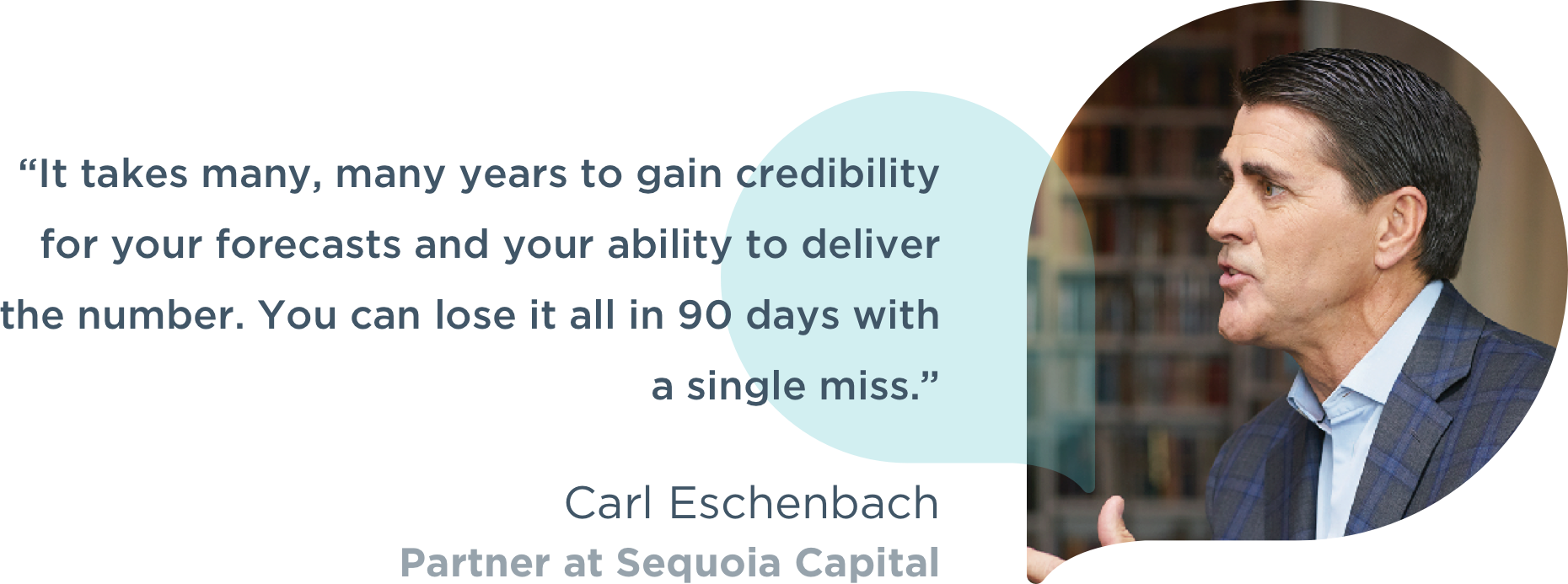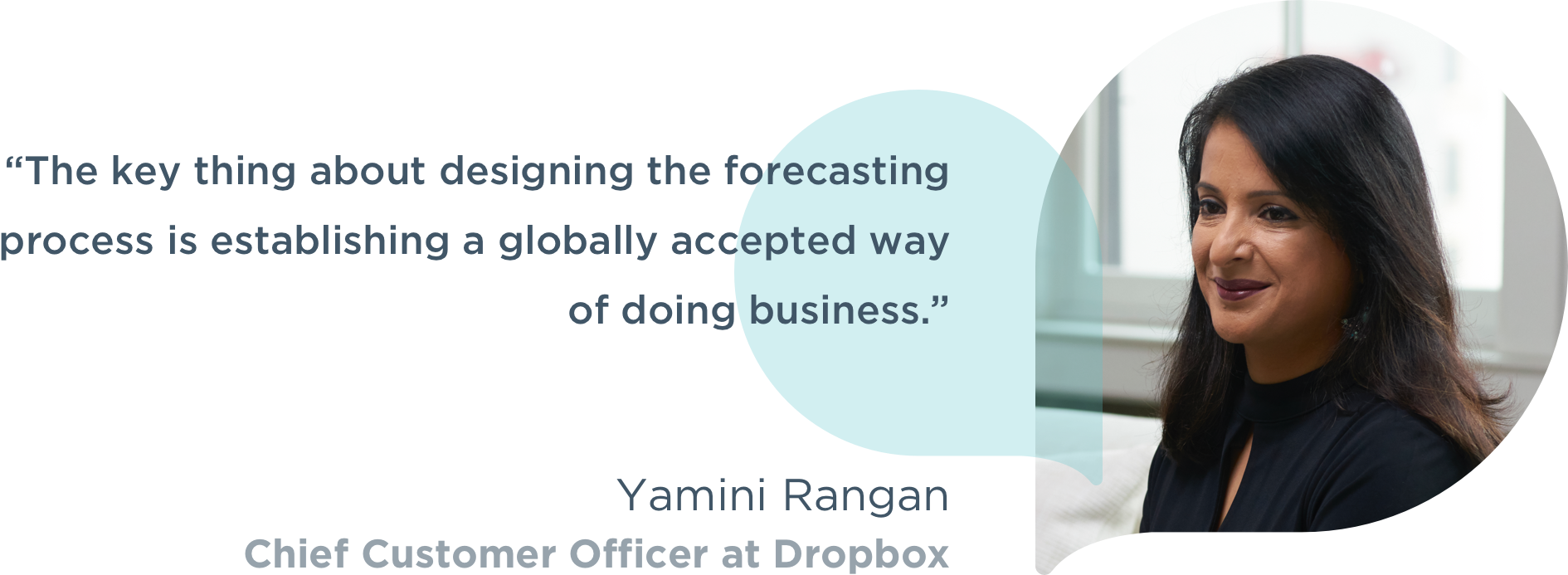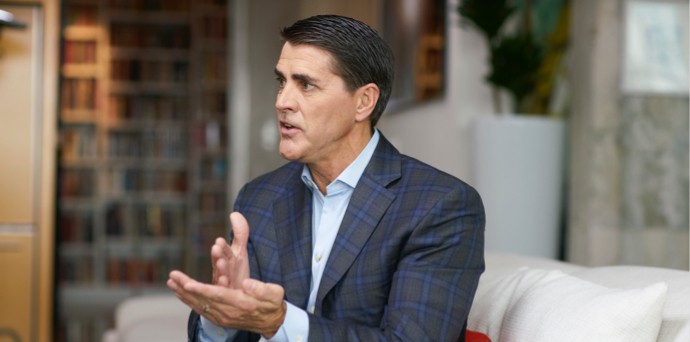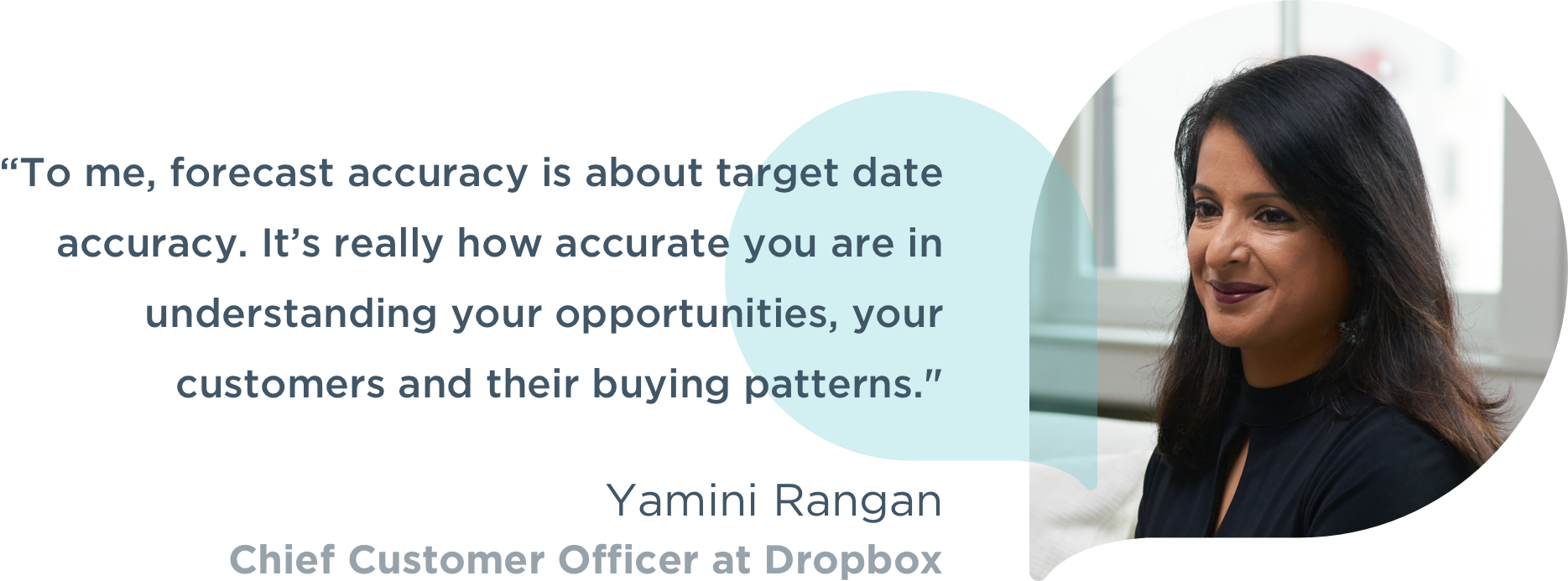How does a sales leader take VMware from $31 million in revenue to $7 billion? What does it take to lead two companies to multibillion-dollar IPOs? Carl Eschenbach, Partner at Sequoia Capital, and Yamini Rangan, Chief Customer Officer at Dropbox, have the answer to both of those questions: forecast accuracy.
Eschenbach and Rangan know a thing or two about growing and leading successful companies, and they both agree: The sales forecast is the most important number to any company. It provides the foundation for the investing and spending decisions that fuel growth.
When the sales forecast is accurate and predictable, companies can invest in the business confidently. When it's not, it can wreak havoc across departments.
Luckily, with all of the tools and data available to revenue teams today, it's gotten a lot easier for reps and managers to call their number with a very high degree of accuracy, making it possible for sales leaders to build a culture centered on accurate forecasting.
In Episode 1 of Masters of Revenue, "Closest to the Pin: How to Create a Culture of Forecast Accuracy," Eschenbach and Rangan reveal 9 tips to create such a culture and ultimately extend it to the larger organization.

1. Take sales forecasting accuracy personally
Culture usually comes from the top down, so if you're going to build a culture of sales forecast accuracy, the sales leader has to make it the top priority. "A sales leader has many hats that they have to wear," Rangan says, "But the most important one is calling the shot on the number."
And, accuracy in calling the shot is their number-one success metric. "There are a number of different ways to measure sales leadership," Eschenbach says. "How well do they hire? How well do they retain people? How good are they at closing big deals? But sales forecast accuracy is the ultimate number that sets great sales leaders apart because the more reliable they are, the smoother the company can run."

Great sales leaders take forecasting personally. "It takes many, many years to gain credibility for your sales forecasts and your ability to deliver the number. You can lose it all in 90 days with a single miss," Eschenbach says.
2. Tie sales compensation to sales forecast accuracy
While culture may start at the top, it has to permeate the entire organization. Tying a portion of incentive compensation to accurate sales forecasting is a very effective way to make that happen.
"Comp is a very, very powerful tool," Rangan says. "You can use it to drive almost any behavior, including forecast accuracy."
There are many ways to design a plan, but both Rangan and Eschenbach recommend that 25% of incentive compensation be tied to sales forecasting. "There are times when you see people try to under-forecast and over-deliver, and all that does is cause under-investment in the company," Eschenbach says. "There are other times that people forecast too high and miss, and then you overspend and that puts the company in a bad position. What you want is an accurate forecast, and incentivizing it drives that home."

Stick with your plan, even if you encounter some resistance. "There was a lot of complaining at the beginning," Rangan says, "But after three quarters, the pattern of the company changed and we got to a point where there was incredible discipline in calling the number."
3. Provide the right sales forecasting tools early on
Of course, incentives will only cause frustration if people aren't equipped for success. One of the top recommendations that Eschenbach gives his portfolio companies is to invest early in tools and systems. More importantly, make sure those tools and systems align with your sales forecasting methods.
"That's something that's really changed over the 30 years I've been doing this," Eschenbach says. "I'm much more inclined now to look at the systems side from day one because if you get too far out before you implement, it's hard to get caught up."
Leverage the tools to learn more about the people on your team. "You have certain sales leaders who have a tendency to always under-forecast, you have other ones who over-forecast, and then you also have to look back at the results from the last quarter," says Eschenbach. "This is where the data and the tooling comes in to actually hold your sales leaders accountable for their accuracy."

4. Create a global sales forecasting process
Another popular recommendation Eschenbach makes to his portfolio companies: Create a globally accepted sales process. That starts with language—putting together consistent definition of leads, pipeline, and deal stages for your company so that you're all on the same page on a sales forecast call.
That means spending the time to define sales and forecast stages that work for everyone across all regions and roles.
"Getting a vernacular in place is really important because what happens as companies grow and you start to go into different regions is that people do things slightly differently," Eschenbach says. "It's hard to rein that back in, so creating a common vernacular that everyone learns the day they start the company will help you become very predictable over time."

It also helps to have everyone using the same sales forecasting tool. "The key thing about designing the forecasting process is establishing a globally accepted way of doing business," Rangan says. "Once established, common tools and language keep everyone within the guard rails."
5. Invest in the sales ops function
Creating predictability in your sales cycles can help you achieve more accurate forecasts. And to create predictability, Eschenbach recommends investing in the sales operations function. "The difference between a great sales organization and a world-class sales organization is sales ops," he says. "I've witnessed how sales ops can make a sales team much more predictable in how they close business, freeing up their time to go out and sell as opposed to worrying about operations."
A good sales ops team is not just creating scoreboards and reports. They're using data and analytics to make recommendations on how the business should move forward. "A scoreboard is a report on something that's already happened. You want to figure out what the play is to put points on the board, and that's what sales operation executives should be doing," he says.

6. Mind the ramp and train for accuracy
As sales teams grow, leaders must be cognizant of the time it takes to get their people ramped up and hitting their number as fast as possible. Investing in training, enablement programs, and tools are just as important to forecast accuracy as hiring reps in the first place.
"It's not uncommon for someone to get a big round of funding, go out and start hiring a whole bunch of sales reps, and then they don't ramp. Then you have 80% of your reps at 40% of their number, and when that happens, attrition sets in," Eschenbach says.
The effect of that trickles downstream to negatively impact almost every area of the company.
"The reason that happens is because you don't know how well you can scale the business, so you end up over-hiring," Rangan says. "You can avoid over-hiring and attrition by building a scalable, predictable, high-accuracy forecast culture."
7. Avoid the "last day of the quarter" syndrome
Constant inspection is imperative of course, and one thing inspections often turn up is a whole lot of deals closing on the last day of the quarter. That's a problem because you're leaving yourself no buffer. It's also a good indication of deals with no real close plan.
"We would run reports and see that 80% of the opportunities in a given quarter were set to close on the last day," Rangan says. "That's not a compelling date for every customer. They can't all be thinking exactly alike, so it has to be something different."

To create a close plan, apply project management skills. Find a compelling event driving the customer to close. Work backward from there to create a reverse timeline for each deal with steps and milestones along the way. And if any one of those action items aren't happening or don't stand the test of inspection, then go back and get clarity on the close plan.
"To me, forecast accuracy is about target date accuracy," Rangan says. "It's really how accurate you are in understanding your opportunities, your customers, and their buying patterns. We actually started limiting our sales managers to 60% of deals closing on the last day of the quarter. If they're going to exceed that, there has to be a compelling reason why."
8. Trust your team, but verify with data
One benefit of a stable sales team is that you start to understand their sales forecasting styles—who has a tendency to be conservative and who tends to be more aggressive. That can offer a clue as to when to use your tools to do a deeper inspection.
"The tooling is just so powerful now that when your company becomes big enough and you have enough data, sometimes you can forecast better with the tools and the systems that you have versus actually talking to the reps because they each have some bias," Eschenbach says.
There's gut feel, and then there's data. "As data has become more important, forecasting has become both art and science," he says. "It's not just about the tools. It's about applying your experience to get the most out of them. It's not one or the other—you have to have both."

9. Make forecast accuracy a team sport
The sales forecast should not be a number that sales alone owns. "Forecasting should be a company-wide sport," Eschenbach says. It's not just the responsibility of sales or marketing. Just like a sales rep is quoted on delivering results every quarter, marketing should be quoted on results delivering top of funnel pipeline through events and programs.
Not only should the forecasting process include marketing, but it should also extend to support, customer success, and even finance.
"Everyone should know about the forecast and somehow be tied to the forecast," Eschenbach says. "When you can up-level it and get the CEO talking about forecast accuracy, it raises awareness of how important that number is."
That's true whether your company is public or private. The sales forecast tells the market what you're going to accomplish, and it also tells the company how to operate.
"In sales, there are two things you have to worry about every quarter: You have to scale, and you have to be predictable," Rangan says. "If you cannot accurately predict what you're going to close, then all of the decisions about what you're investing in other functions fall apart. If you can get your forecast to be as accurate as possible and you can get the whole company aligned on the importance of forecast accuracy, then the investments come through and you know exactly how to build."
For more Masters of Revenue content, visit the Masters of Revenue page.




